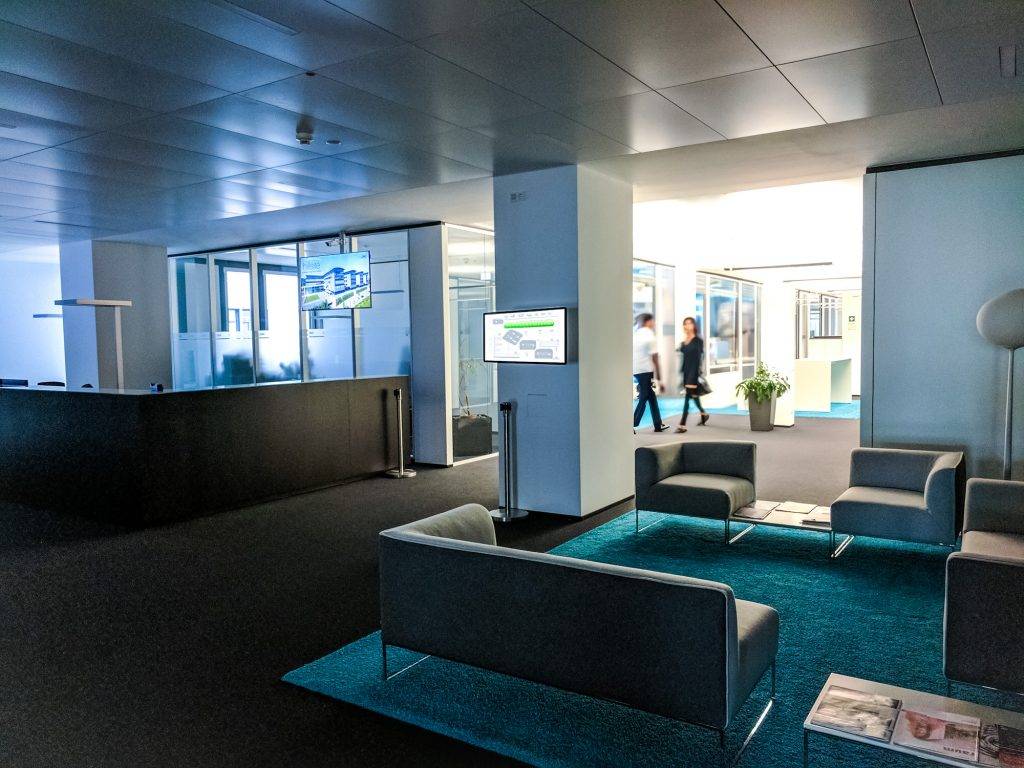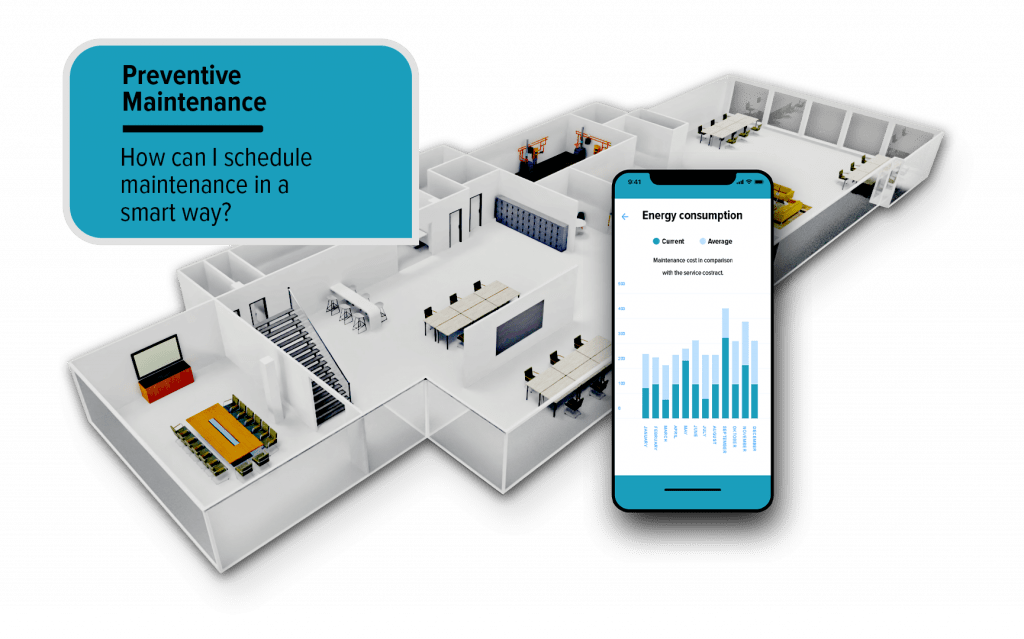
Step by step, many companies unconsciously sleepwalk into the future of workplace design. How do we notice this shift? The workplace – a space that transcends its physical dimensions. It’s an environment evolving to meet modern corporate needs. But how can we simultaneously maximize spaces to enhance performance and achieve sustainable goals? This guide is a compass for architects, facility managers, and entrepreneurs navigating the labyrinth of AI-supported spatial optimization in commercial settings.
Content:
- The foundation: Workspaces in transition
- Areas of application – Where AI delivers the greatest benefits for workspace optimization
- ESG goals – AI for a better world?
- Other considerations – data privacy, ethics, and long-term perspectives
- What could go wrong?
- The solution to the challenge of optimizing space?
- What to do next?
Embracing change and innovation, many companies are cautiously treading the path of digital transformation and workspace optimization. But what does this mean for the physical spaces we share and utilize daily? How does technological evolution express itself in lighting, air conditioning, desk setups, and meetings? Let’s explore how artificial intelligence (AI) and smart building technologies shape our workplaces, promoting sustainability and employee satisfaction when optimized spaces and work environments.
The foundation: Workspaces in transition
Seen as the embodiment of all corporate goals in physical form, commercial spaces serve as the linchpin bridging business strategy and execution. They transcend mere square footage and expenses; they act as the stage where productivity thrives or falters.
How space works in the workplace
Every inch of space narrates the tale of resource allocation and utilization. It encapsulates a narrative of decisions at the core of every company’s financial planning. A square meter in Bangkok differs from one in New York, not just in terms of price but also regarding its value to the company and its employees.
Costs versus benefits – an eternal conflict
Every space utilization needs to balance efficiency and comfort. Efficiency is not only an economic goal but also an ecological and communal one. The benefits must be evaluated from multiple perspectives to discover the most optimal, sustainable solution for businesses.
The silent exploration of new horizons
Area optimization is not about working on a millimeter scale; it involves advanced gigabyte calculations using modern technology. The aim is to utilize valuable spaces in a way that meets both current and future requirements. How can AI assist us in overcoming this challenge?
Optimizing space with AI – Beyond just savings
Using AI in space management and workspace optimization offers more than cost reductions. Companies can achieve social, economic, and environmental goals by intelligently adapting spaces to meet employees’ needs.
AI – The architect of the office of the future
The architect of the future office is not so much a bridge-builder as a digital wizard of artificial intelligence. AI can analyze spatial data and user behavior to design offices that match individual work styles and needs perfectly.
Areas of application – Where AI delivers the greatest benefits for workspace optimization
AI algorithms enhance space management by boosting efficiency, increasing user comfort, and achieving ambitious sustainability goals. The possibilities are diverse and remarkable, from automating workspaces to implementing advanced visitor management and enhancing the workplace experience.
Workplace automation – Efficient and adaptable
Automating the workplace through AI goes beyond simple adjustments like lighting, climate, and desk height. Modern AI-driven systems can proactively schedule maintenance by analyzing data from various sensors to detect signs of impending failures before they occur. Additionally, cleaning cycles can be intelligently adjusted based on actual space utilization, leading to more efficient cleaning and optimized use of cleaning agents, thereby promoting environmental friendliness.

Another impressive example lies in the proactive optimization of energy consumption within buildings. AI systems can regulate heating, cooling, and lighting by analyzing weather forecasts, usage data, and calendars (such as upcoming meetings or events) to ensure maximum comfort with minimal energy usage. Companies that have integrated such technologies typically observe a significant reduction in energy consumption, highlighting the potential of these systems.
Visitor and guest management – the reception of the future
Using AI in visitor and guest management revolutionizes visitors’ initial impression of a company. For instance, a smart reception system can display personalized greetings on screens based on prior appointments or facial recognition. This ensures a modern and customized welcome and enhances security by accurately tracking who is in the building and when. Streamlined visitor registrations become effortless with AI-based systems.
By integrating with existing calendars and planning tools, visitors can be pre-registered with all necessary information – such as Wi-Fi access codes or agendas – automatically provided. Furthermore, such systems enable guided tours of the building via augmented reality on the visitor’s smartphone, which can be particularly advantageous in large or complex structures.
Improving workplace experience – Just one click to happiness?
Enhancing the workplace experience through AI goes beyond the physical setup. Apps and AI systems that display available workspaces in real-time simplify meeting room bookings and connect employees with similar interests and goals within the company, significantly contributing to a positive and productive work environment.
A concrete example of this is an AI-powered tool that shows available workspaces and rooms and provides recommendations based on the employee’s individual preferences and the requirements of their current tasks. Such systems can even suggest learning and break spaces that align with the user’s needs, enhancing well-being and productivity.
How is everything evolving?
An article in the German Capital Magazine refers to a study by PwC, stating, “Both employers and employees believe that additional investments are necessary for a shift to even more home office setups. On average, over half of the workforce (57 percent) has the required technical equipment. Employers anticipate investments averaging 950 euros per employee. Additional costs include meeting room expenses and flexible workplace desk sharing. Employers estimate the upcoming renovation costs to be an average of 220 euros per square meter.”
AI-driven solutions for workspace optimization in space management offer excellent opportunities to enhance the work environment, making it more intelligent, more pleasant, and more sustainable. By utilizing these technologies, companies can lower operational costs, improve the workspace for employees, and support environmental conservation efforts.
ESG goals – AI for a better world?
How could workspace optimization make the world better? The whole world? Indeed. When everyone works on their buildings, the entire world is eventually optimized. However, step by step, the responsibility for the environment, society, and responsible corporate governance continues to grow. AI provides solutions to operate more sustainably in this area as well. Integrating Artificial Intelligence (AI) into space optimization and facility management can help companies achieve their Environmental, Social, and Governance (ESG) goals. ESG goals are increasingly important as they aim not only for sustainable business practices but also for improving social responsibility and corporate governance. Below, we highlight some ways in which AI can contribute to this effort:
Environmental
- Energy efficiency: AI-driven solutions can significantly decrease energy consumption by optimizing heating, ventilation, air conditioning, and lighting systems. This reduces operating costs and diminishes the company’s carbon footprint.
- Resource management: AI can help efficiently utilize water and other resources by detecting leaks and suggesting preventive maintenance to minimize waste.
- Sustainable workspace utilization: AI can optimize space requirements and reduce redundant areas by analyzing usage data, leading to lower energy and resource consumption.
Social
- Employee well-being: AI-driven systems have the potential to create work environments that enhance the health and well-being of employees. This can be achieved by ensuring optimal air quality, appropriate lighting, and facilitating flexible workspaces.
- Inclusion and accessibility: AI-driven solutions contribute to a more inclusive workplace culture by tailoring the physical environment to accommodate the needs of all employees, including those with disabilities.
- Data privacy and ethics: Implementing AI solutions that adhere to data protection standards and ethical considerations builds stakeholder trust and enhances the company’s social capital.
Governance
- Transparency and compliance: AI can help meet compliance requirements and simplify reporting by collecting and analyzing data relevant to ESG reporting. This enhances transparency towards investors and other stakeholders.
- Risk management: AI can enhance risk management and strengthen corporate governance by identifying potential environmental compliance issues or workplace safety issues.
Companies utilizing AI solutions for space optimization and facility management can boost efficiency and significantly contribute to achieving their ESG goals. This promotes sustainable practices and enhances the company’s reputation as a responsible societal player.
Other considerations – data privacy, ethics, and long-term perspectives
Knowledge is power, but can we still look our mother in the eye when our ray gun-like AI fires aimlessly? What does this mean in the face of the automated AI-driven world of space management?
Data privacy and ethics – Blessing and curse alike
Ethical principles and data protection regulations must be harmonized with the integration of AI solutions to maintain employees’ trust, even when it’s about workspace optimization. Transparent processes and open dialogue are crucial. But what about the Big Data dilemma? Bigger, faster, farther – but not at any cost. Data volumes can only be beneficial when their collection and analysis are done ethically and comply with data protection. Most AV technology and video conferencing meeting rooms don’t necessarily need to be a red flag here but include them in your management plan.
Dashboards are effective tools for visualizing data and providing a quick overview of various metrics. Post-data collection dashboards enable the analysis and transformation of data into meaningful insights. Interpreting this information allows for well-informed decisions based on a solid data foundation. A well-designed dashboard empowers managers and decision-makers to grasp complex data and turn it into actionable knowledge, enhancing the efficiency and effectiveness of space management decisions, whether on a single floor or across multiple buildings worldwide.
Future prospects – a cosmic duel
What does the future hold? That remains a mystery. Nevertheless, it’s crucial to ponder what’s feasible now and what might become vital.
- AI as an adaptation tool: The world is in constant flux – why shouldn’t space management also remain adaptable? AI could be the key.
- Data collection and quality: Current turmoil or enduring strength? The quality of gathered data will determine whether AI solutions for space optimization are short-lived trends or create lasting corporate value.
- Machine learning as AI 1.0: Step by step, machines, and AI players are carving a path into the heart of corporate structures. Machine learning is just one of many steps propelling us to the next level of digital evolution, whether through embedding IoT sensors or running an app solely on software.

Where does the app end and the smart building begin? As often is the case, the transition is rather seamless. The AI clock’s chime: When is the right time to implement AI technologies? Experimentation and continuous learning are the guiding principles to ensure the company’s digital transformation clock ticks reliably.
What could go wrong?
Implementing AI solutions to optimize space utilization aims to proactively enhance operational efficiency and address issues. However, this path may present various challenges that businesses must navigate carefully.
Resistance of employees – a continuity of change
Any transformation within a company may encounter resistance, especially when introducing new technologies like AI. Employees might feel threatened by the changes due to fear of the unknown or concern about being replaced by machines. To address these challenges, it is crucial to involve employees early in the process and communicate transparently about the goals and benefits of the new technologies. An inclusive approach, including feedback loops and training opportunities, can help to engage employees as allies in the transformation rather than potential adversaries.
According to reports by the German publication Spiegel, the project is about optimizing space – some refer to it as a flop and complain about cramped conditions. However, it is also noted that communication is more accessible when you don’t have to knock on doors, but open-plan offices reduce privacy. Therefore, there is a need for quiet corners and individual offices where employees can ponder challenging tasks. Not everyone works productively and happily when their colleagues can constantly see and hear them.
Inefficient use of technology
Even the most advanced technology cannot reach its full potential without effective utilization. The challenge lies in seamlessly integrating AI into existing workflows and processes. This requires technical expertise and a profound understanding of the company’s operations. Often, adapting processes is necessary to leverage the technology optimally. Therefore, companies should be prepared to critically examine and adjust their operations to harness AI’s benefits fully. Not everything that seemingly augments your workspace optimization project will lead to progress, so make sure to monitor progress as well.
Data protection and security risks
Implementing AI systems brings along data privacy and security risks. Processing sensitive company and employee data requires stringent security measures and clear data protection policies. Success hinges on transparent communication regarding data handling and the implementation of robust security systems to ensure trust among employees and stakeholders.
Lack of adaptation to business needs
Businesses need a tailored AI solution to reap significant benefits. Conducting a thorough analysis of operational processes and needs is crucial to crafting a bespoke solution. This often entails close collaboration between the company and AI technology providers to ensure the implemented solution yields the desired outcomes. Do not forget your workspace optimization goals; don’t get lost along the journey.
Subversion of the company culture
The corporate culture plays a pivotal role in successfully implementing new technologies. AI systems should be designed and deployed in a manner that reflects and supports the company’s values and principles. Technology that contradicts the corporate culture can lead to conflicts and diminish employee acceptance. Hence, it is crucial to select technology solutions that enrich and reinforce the corporate culture rather than undermine it.
Integrating AI into facility management requires careful planning, a deep understanding of operational processes, and strong employee involvement. This approach enables companies to navigate potential pitfalls and realize the full benefits of the technology.
The solution to the challenge of optimizing space?
AI in space optimization is more than just technology – it’s a strategy to shape the modern workplace sustainably. However, it also presents a dual challenge and responsibility.
- AI and the future of space management: Space optimization with AI is not merely a buzzword but the tangible reality we are heading towards. Companies that recognize and leverage its potential will establish a sustainable market position.
- The potential of AI solutions: The opportunities of AI in space management are virtually limitless. Combined with a smart corporate strategy, AI can become a potent competitive tool.
- Strategic approaches – A systematic path to success: A vision without a plan is like a journey without a map. Clear overarching objectives for space optimization must be defined and pursued systematically.
- The value of good data and analyses: Data is the raw material, and analysis is the tool. Only with quality data and analyses can the possibilities of AI in space management be maximized.
- Implementation and monitoring of ESG measures: ESG goals are not fleeting trends. Their implementation needs continuous monitoring and control, especially in the context of AI applications.
- A better work environment for employees and visitors: Enhancing employee and visitor satisfaction is the cornerstone of sustainable space optimization. AI can contribute to improving the workplace and creating a positive experience.
What to do next?
Specific steps are necessary to move beyond thinking and start taking action toward a workspace optimization strategy. Here are five key recommendations to kick off the transformation using AI solutions.
- Assess your current status: An honest evaluation is the first step toward optimizing your space. Where do you stand now, and where do you aim to be in the future?
- Explore AI options: The market offers a variety of AI solutions for space management. Identify the ones that align best with your needs.
- Initiate a pilot phase: Introducing AI solutions should be carefully planned. A pilot phase lets you gather initial experiences and tailor the solution to your operational circumstances.
- Educate your team: The acceptance of AI solutions hinges on the qualifications of your staff. Train your team and involve them actively in the change process.
- Take action: The best time to make an impact was yesterday. Act now to shape the future of your spaces with AI. The stage is set – AI in space management is not a distant vision but an unfolding symphony reshaping the scripts of daily work life. It’s time to take the baton and compose the symphony of your spaces.
AI is not a far-off dream. It’s not a luxury reserved for big corporations. AI is here, ready to optimize your office spaces. Be proactive and help shape the workplace for tomorrow. Technology like apps or other software can significantly assist in this endeavor but do not lose sight of your primary objectives. If you want to proceed with workspace optimization in your company or have questions, contact us today.